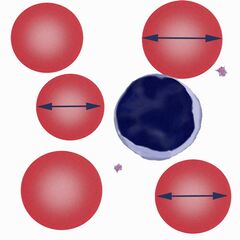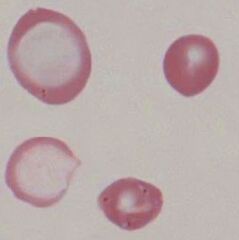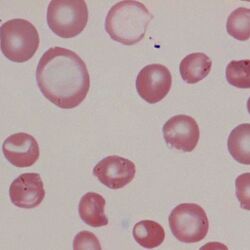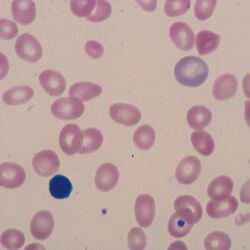Anisocytosis
From haematologyetc.co.uk
Derivation: From the Greek Aniso [Unequal] and Greek Cytosis [referring to a cell]
Description
Like poikilocytosis, this simple term simply describes variation between cells – in this case their size when flattened on blood smears; the term is often used as a “catch all” description, but lacks value since it does not describe how cells vary (e.g. large and normal, small and normal etc) or the type of cells involved.
Appearance: The key points are that different cells have variability in size, often such cells will also have variability in shape (poikilocytosis). A small image from a clinical case is shown for comparison.
Significance
Although a non-specific term there is a value in recognising anisocytosis: on a normal smear red cells present a fairly uniform population. In disease states, one of the first changes noticed by the morphologist is an increased variation either in cell shape or cell size. Anisocytosis should not be regarded as a diagnosis, and the term generally has little value to clinicians. However, for a morphologist spotting this variation should be an indication to look further.
Pitfalls
Always make sure there is not a better term to use than anisocytosis – why is there variability in size? Could the appearances better be described by another term?
Recommendation
Look for anisocytosis but avoid using it as a description term on a report – it is always better to describe the nature of the variation (see images).
Gallery
Clinical Image 1: Variation in colour and size in this image is caused by a combination of severe hypochromia, polychromasia, and partial transfusion. Clinical condition: Partly treated severe thalassaemia (hydrops)
Clinical Image 2: The variable colour in this case reflects a dimorphic blood film with hypochromic and transfused cells - more accurately described as dimorphic. Clinical condition: transfused severe iron deficiency.



